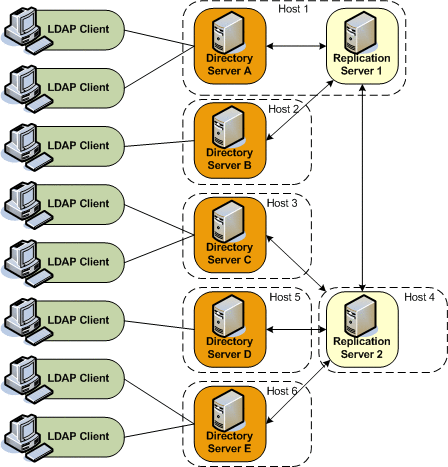| Exit Print View | |
Sun OpenDS Standard Edition 2.2 Administration Guide |

|
Starting and Stopping Your Server Instance
Configuring the Server Instance
Configuring the Proxy Components
Configuring Security Between Clients and Servers
Configuring Security Between the Proxy and the Data Source
Configuring Servers With the Control Panel
Configuring Data Replication With dsreplication
To Enable Replication Between Two Servers
To Initialize a Replicated Server
To Initialize an Entire Topology
To Obtain the Status of a Replicated Topology
Modifying the Replication Configuration With dsconfig
Retrieving the Replication Domain Name
Changing the Replication Purge Delay
To Change the Replication Purge Delay
Changing the Heartbeat Interval
To Change the Heartbeat Interval
To Change the Isolation Policy
Configuring Encrypted Replication
To Configure Encrypted Replication
Configuring Replication Groups
To Configure A Replication Group
Configuring Assured Replication
To Configure Assured Replication in Safe Data Mode
To Configure Assured Replication in Safe Read Mode
Configuring Fractional Replication
Configuring Replication Status
To Configure the Degraded Status Threshold
Initializing a Replicated Server With Data
Initializing a Single Replicated Server
Initializing a New Replicated Topology
Adding a Directory Server to an Existing Replicated Topology
Changing the Data Set in an Existing Replicated Topology
To Change the Data Set With import-ldif or Binary Copy
Appending Data in an Existing Replicated Topology
To Initialize a Client Application to Use the External Change Log
Configuring Schema Replication
Replicating to a Read-Only Server
To Configure a Replica as Read-Only
Detecting and Resolving Replication Inconsistencies
Types of Replication Inconsistencies
In particularly large topologies, it is often simpler to configure dedicated replication servers (servers that do not include a directory server) and dedicated directory servers (servers that do not included a replication server).
A dedicated directory server contains replicated data but does not contain a change log with the modifications made to that replicated data. A dedicated directory server also has no configured replication port. A dedicated replication server has a configured replication port. The server does not contain replicated data but does contain a change log with the modifications made to the replicated data on other servers in the topology.
Note - Each topology must have at least two replication servers to avoid a single point of failure.
For more information and sample topologies, see Chapter 5, Example Deployments Using the Directory Server, in Sun OpenDS Standard Edition 2.2 Deployment Planning Guide.
The following diagram illustrates a large replication topology with one dedicated replication server (Replication Server 2), four dedicated directory servers, and one servers that contains both a replication and a directory server (Host 1).

To configure a dedicated directory server, use the --noReplicationServer1 or --noReplicationServer2 option when you enable replication between two directory servers. This example configures replication between the directory server instances A and B in the previous illustration.
$ dsreplication enable \ --host1 host1 --port1 4444 --bindDN1 "cn=Directory Manager" \ --bindPassword1 password --replicationPort1 8989 \ --host2 host2 --port2 4444 --bindDN2 "cn=Directory Manager" \ --bindPassword2 password --noReplicationServer2 \ --adminUID admin --adminPassword password --baseDN "dc=example,dc=com" -X -n
To configure a dedicated replication server, use the --onlyReplicationServer1 or --onlyReplicationServer2 option when you enable replication between two servers. This example configures replication between Directory Server C and Replication Server 2 in the previous illustration.
$ dsreplication enable \ --host1 host3 --port1 4444 --bindDN1 "cn=Directory Manager" \ --bindPassword1 password --noReplicationServer1 \ --host2 host4 --port2 4444 --bindDN2 "cn=Directory Manager" \ --bindPassword2 password --onlyReplicationServer2 \ --replicationPort2 8989 --adminUID admin --adminPassword password \ --baseDN "dc=example,dc=com" -X -n